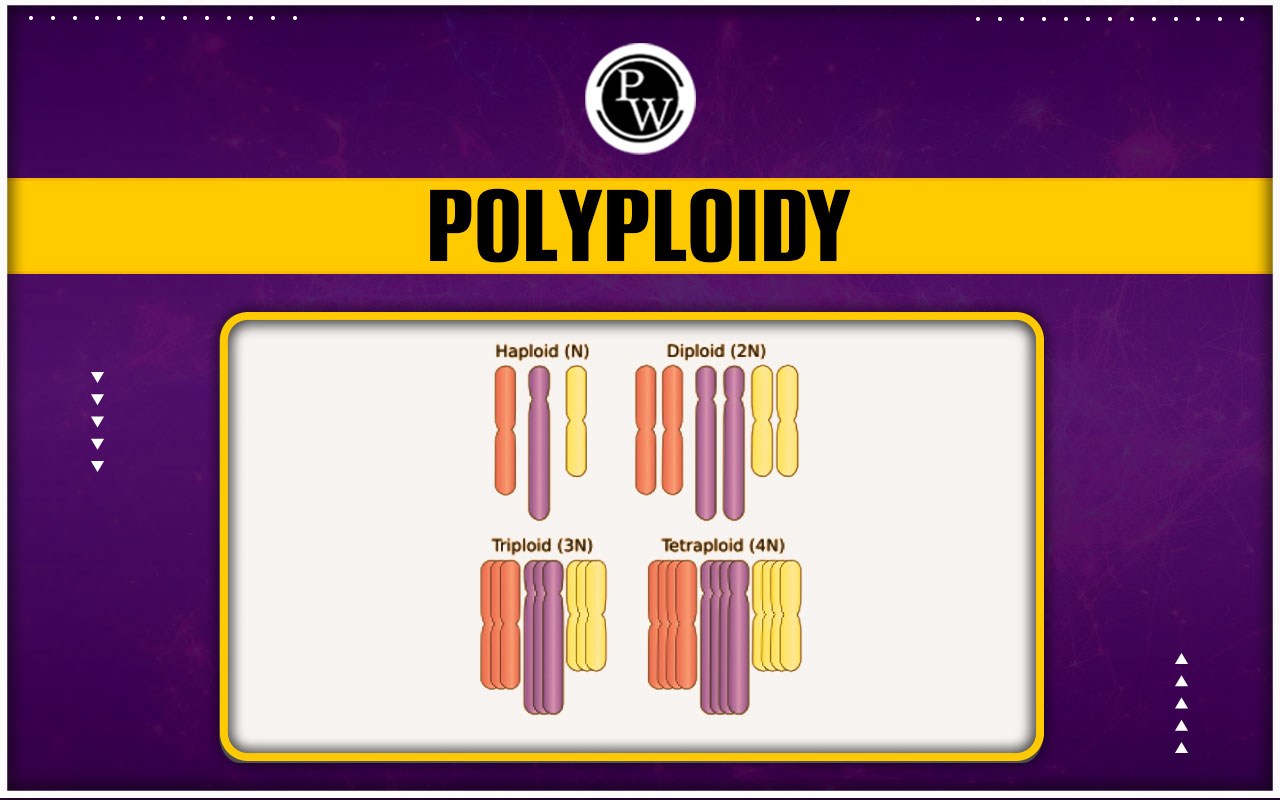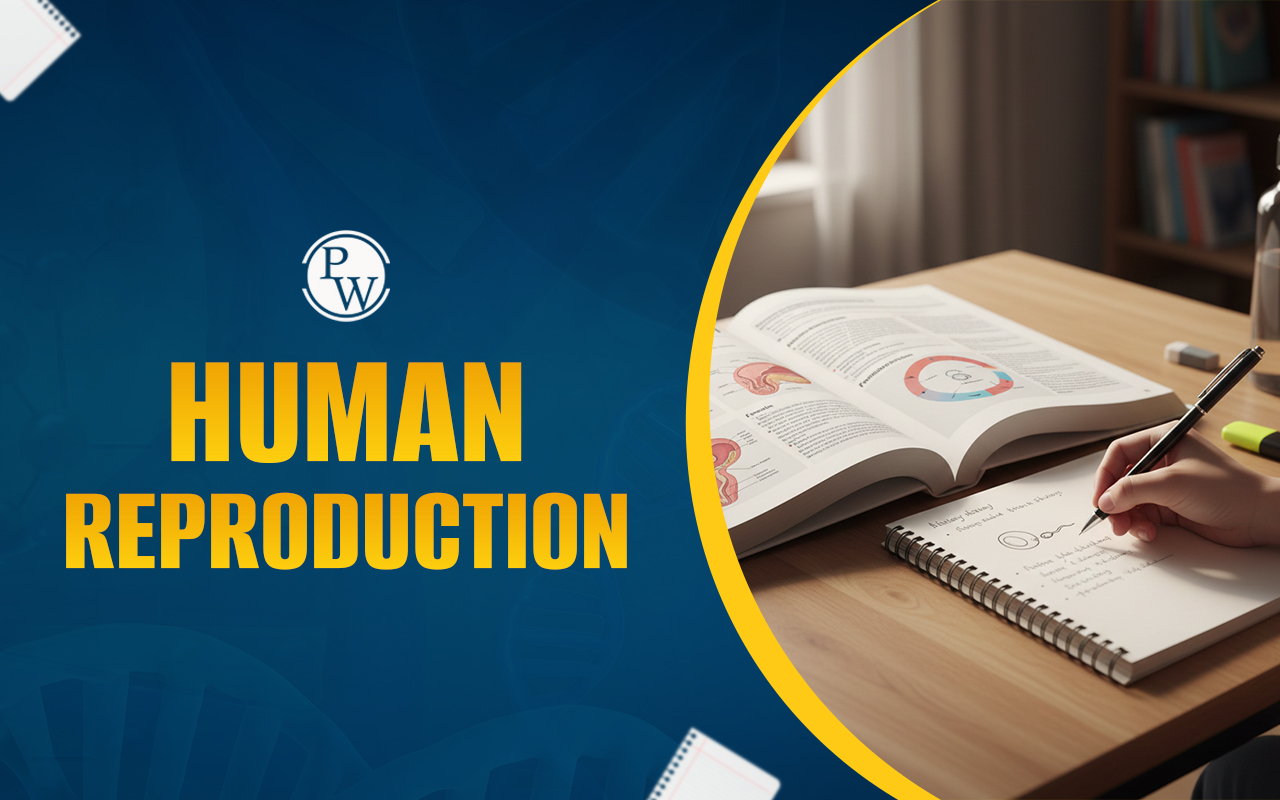

Polyploidy: When an organism's cells contain more than one set of homologous chromosomes, it is called polyploidy. Polyploidy can occur when chromosomes do not separate properly during meiosis or when an egg is fertilized by more than one sperm. This condition is inherited and results in an organism having more than two complete sets of chromosomes.
Polyploidy arises due to nondisjunction in human cells, which happens when homologous chromosomes fail to separate during meiosis. In humans, this condition is lethal. However, polyploidy is common in certain organisms, such as flowering plants, salamanders, frogs, and leeches. These organisms are well adapted to their environments and have unique advantages due to their polyploidy. NEET aspirants should refer to the Polyploidy NEET Biology Notes in the article below.
Polyploidy Meaning
Polyploidy refers to a chromosomal alteration where an organism has two or more complete sets of chromosomes. The prefix "poly" means "many," and "ploidy" refers to sets of chromosomes, so polyploidy translates to "many sets of chromosomes." The ploidy level indicates the number of chromosome sets in a somatic cell, which includes all body cells except sex cells.
The term ploidy number (n) denotes the haploid number of chromosomes, which is the number of chromosomes in a single set of unpaired chromosomes found in an organism's sex cells.
For example, bacteria are monoploid (n), while humans are diploid (2n). Polyploid organisms can be triploid (3n), tetraploid (4n), hexaploid (6n), or octoploid (8n). The number before the "n" indicates the total sets of chromosomes in the organism. Typically, individuals with an odd number of chromosome sets are infertile because their chromosomes cannot pair up correctly during meiosis.
Sexual Reproduction in Flowering Plants
Types of Polyploidy
Polyploidy is when an organism has more than the usual two sets of chromosomes in its cells. This can occur in different ways, leading to various types of polyploidy. The following are the three major types of polyploids:
- Allopolyploids
- Autopolyploids
- Autoallopolyploids.
1. Autopolyploidy
This occurs when an organism has multiple copies of the same set of chromosomes. For instance, a triploid (AAA) organism has three sets of chromosomes, while a tetraploid (AAAA) organism has four sets. Autopolyploidy can result from errors during cell division, such as mitosis or meiosis.
In mitosis, sister chromatids fail to separate and end up in the same daughter cell. In meiosis, homologous chromosomes don't separate properly, resulting in gametes with extra chromosomes.
- Autotriploid (AAA): This type of polyploidy involves three sets of chromosomes. Autotriploids are often sterile because their homologous chromosomes have difficulty pairing correctly during meiosis, leading to gametes with an uneven number of chromosomes and inviable offspring. However, some autotriploids can reproduce asexually.
- Autotetraploid (AAAA): Organisms with four sets of chromosomes are called autotetraploids. They are more common than triploids and can be fertile because they can pair their homologous chromosomes during meiosis. Autotetraploidy can offer several advantages, such as increased size, improved stress tolerance, and larger flowers or fruits.
Structural Organisation in Animals
2. Allopolyploidy
This occurs when an organism has multiple sets of chromosomes from different species. It typically happens following hybridization, where the offspring receive a complete set of chromosomes from each parent.
The chromosomes from different species may not pair correctly during meiosis, leading to sterility. However, if the allopolyploid undergoes a chromosome doubling event, it can result in a fertile individual with four complete sets of chromosomes (AABB).
- Allotetraploid (AABB): This is the most common type of allopolyploidy. It arises from the hybridization of two different species followed by a chromosome doubling event. Allotetraploids are often fertile because they have two complete sets of chromosomes from each parent, allowing for proper pairing during meiosis. Many important crop plants, such as wheat, cotton, and potatoes, are allopolyploids.
3. Auto-allopolyploidy
This is a combination of autopolyploidy and allopolyploidy. It can occur when an autopolyploid individual hybridizes with another species.
The effects of polyploidy on organisms can vary depending on the specific type and the organism itself. However, polyploidy can play a significant role in speciation and evolution. It can also be used in plant breeding to create new varieties with desirable traits.
| Important NEET Biology Notes | ||
|---|---|---|
| Selaginella | Embryo | Malvaceae |
| Pinus | Polyembryony | Volvox |
Polyploidy in Plants
Polyploidy is when an organism has more than two complete sets of chromosomes. In plants, polyploidy is a common and significant phenomenon, playing a important role in their evolution, diversity, and adaptation.
Examples of Polyploid Plants
- Wheat ( Triticum spp .): Bread wheat is hexaploid (6n), resulting from hybridization and chromosome doubling events involving three different species.
- Cotton ( Gossypium spp .): Many cotton species are tetraploid, combining genomes from different progenitor species.
- Strawberry ( Fragaria × ananassa ): Cultivated strawberries are octoploid (8n), resulting from hybridization between two different octoploid species.
- Potato ( Solanum tuberosum ): Cultivated potatoes are tetraploid.
| Important NEET Biology Notes | ||
|---|---|---|
| Chara | Funaria | Apomixis |
| Rhizopus | Spirogyra | Bacteriophage |
Polyploidy in Agriculture and Horticulture
Polyploidy is used in agriculture to develop crops with desirable traits such as larger fruits, improved disease resistance, and greater adaptability to different environmental conditions. Breeders often induce polyploidy artificially using chemicals like colchicine, which disrupts normal chromosome segregation during cell division.
Polyploidy in Humans
Polyploidy is a rare phenomenon in humans and usually disrupts normal development. It involves cells or organisms having more than the usual two complete sets of chromosomes. In humans, having an extra set of chromosomes (triploidy, where there are three sets instead of two) typically leads to early embryo death. This condition often results in miscarriage or stillbirth.
However, certain tissues or specific conditions, like in cancer cells, can show some forms of polyploidy. In cancer, abnormal cell division may cause cells to have abnormal chromosome numbers (aneuploidy), which differs from normal polyploidy. In summary, polyploidy is abnormal in human development and is linked with significant abnormalities and health problems when it occurs.
Polyploidy in Plant Breeding
Polyploidy is a significant factor in plant breeding, providing unique advantages for improving crops. It refers to organisms having more than two complete sets of chromosomes, which can occur naturally or be induced artificially in plants. In plant breeding, polyploidy is particularly valuable for several reasons:
Polyploidy is crucial in plant breeding, involving organisms with more than two complete sets of chromosomes, occurring naturally or induced artificially. Its benefits include:
- Enhanced Vigor and Size: Polyploid plants grow larger and faster, boosting yields and biomass production.
- Increased Genetic Diversity: Polyploidy introduces greater genetic variety, helping breeders select plants with desired traits.
- Infertility Barrier: Polyploidy prevents cross-pollination with diploid plants, maintaining crop purity.
- Hybrid Vigor: Polyploid hybrids often exhibit superior traits, enhancing breeding programs.
- Seedless Varieties: Polyploidy creates seedless fruits like watermelon and grapes.
- Adaptation to Harsh Environments: Polyploid plants tolerate environmental stresses like drought and heat, crucial for resilient crop breeding.
Polyploidy is induced through methods like colchicine treatment, doubling chromosomes by disrupting cell division. It enables breeders to enhance productivity, improve quality, and increase crop resilience.
Polyploidy in Pharmacology
Polyploidy in pharmacology refers to cells or organisms having more than the usual two sets of paired chromosomes. This can happen accidentally or on purpose during research. In pharmacology, polyploidy is particularly important for treating cancer.
Certain chemotherapy drugs, called spindle poisons, can induce polyploidy in cancer cells. This abnormality disrupts cell division, causing the cells to either die or stop growing, which helps treat fast-growing cancer cells. Researchers also study polyploidy to understand how it contributes to drug resistance and disease progression, which could lead to new treatment approaches.
Polyploidy Examples
Polyploidy is a genetic occurrence where an organism possesses more than two complete sets of chromosomes. This can happen due to errors during cell division or by merging chromosomes from different species. The following are the examples of polyploidy:
Plants
- Wheat (Hexaploid): Wheat has six sets of chromosomes, likely resulting from hybridization between different grass species.
- Strawberries (Octaploid): These fruits have eight sets of chromosomes, contributing to their large size and juicy texture.
- Bananas (Triploid): Bananas have three sets of chromosomes and reproduce through parthenogenesis, which explains their seedlessness.
- Potatoes (Tetraploid): Potatoes possess four sets of chromosomes, enhancing their size and starch content.
- Cotton (Allopolyploid): Cotton resulted from hybridization of two ancestral species, giving it unique textile properties.
Animals
- Amphibians: The African clawed frog ( Xenopus laevis ) is tetraploid, a rare occurrence in vertebrates often resulting from hybridization events.
- Fish: Some ornamental goldfish varieties, like Carassius auratus , are triploid, affecting their size and reproductive abilities.
Insects
- Ants: Polyploidy is observed in certain ant species, such as the fire ant ( Solenopsis invicta ), influencing colony structure and behavior.
Fungi
- Mushrooms: Examples include the button mushroom ( Agaricus bisporus ), where polyploidy affects growth and fruiting traits.
Polyploidy plays a significant role in various organisms' diversity, adaptability, and evolutionary success, from plants and animals to fungi, influencing their genetic traits and ecological roles.
Polyploidy vs Aneuploidy
The table below shows the key differences between polyploidy and aneuploidy, including their definitions, genomic content, mechanisms, biological effects, and examples in different organisms.
| Polyploidy vs Aneuploidy | ||
| Feature | Polyploidy | Aneuploidy |
| Definition | Condition where organism has more than two sets of chromosomes. | Condition where organism has an abnormal number of chromosomes (not a complete set). |
| Genomic Content | Involves entire sets of chromosomes (e.g., 3n, 4n). | Involves individual chromosomes (e.g., 2n+1, 2n-1). |
| Mechanism | Can occur through duplication of entire genome (autopolyploidy) or combination of chromosomes from different species (allopolyploidy). | Often caused by errors in cell division processes such as nondisjunction during meiosis or mitosis. |
| Biological Effects | Can lead to larger cell sizes, enhanced vigor, and adaptability in plants. | Often results in developmental abnormalities and health issues in animals, including humans. |
| Examples | Common in agricultural crops like wheat and bananas. | Examples include Down syndrome (trisomy 21), Edwards syndrome (trisomy 18), and Patau syndrome (trisomy 13) in humans. |
Physics Wallah offers the NEET Online Coaching to excel in the NEET exam. PW provides online coaching with high-quality lectures, study materials, and expert faculty. PW offers live online classes, study guides, and tests for NEET class 11 students. Enroll Now!
| NEET Exam Important Links | |
|---|---|
| NEET Biology Syllabus | NEET Biology Diagrams |
| NEET Biology MCQ | NEET Biology Chapter wise Weightage |
| NEET Biology Notes | NEET Previous Year Question papers |
Polyploidy FAQs
What is polyploidy in humans?
What is polyploidy and aneuploidy?
What are examples of polyploidy in plants?
What are the applications of polyploidy?
Are humans polyploid?












